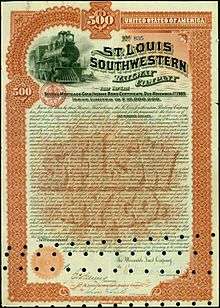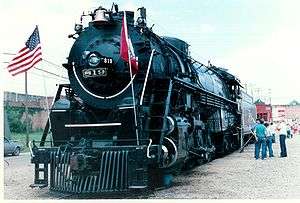St. Louis Southwestern Railway
 | |
.svg.png) Cotton Belt system as of 1918 | |
| Reporting mark | SSW |
|---|---|
| Locale | Arkansas, Illinois, Kansas, Louisiana, Missouri, New Mexico, Oklahoma, Tennessee and Texas |
| Dates of operation | 1891–1992 |
| Successor | Southern Pacific Railroad and Union Pacific Railroad |
| Track gauge | 4 ft 8 1⁄2 in (1,435 mm) standard gauge |
| Headquarters | St. Louis, Missouri |
The St. Louis Southwestern Railway (reporting mark SSW), known by its nickname of "The Cotton Belt Route" or simply Cotton Belt, is a former US Class I railroad which operated between St. Louis, Missouri, and various points in the states of Arkansas, Tennessee, Louisiana, and Texas from 1891 to 1980. In 1980 the Cotton Belt began operating the Rock Island's Golden State Route which added the states of Kansas, Oklahoma, and New Mexico to the operation. Operation of the Cotton Belt was assumed by parent Southern Pacific in 1992.
Corporate history

The Cotton Belt was one of the lines comprising the railroad empire acquired by financier Jay Gould in the last quarter of the 19th century; according to the Handbook of Texas, "By 1890 Gould owned the Missouri Pacific, the Texas and Pacific, the St. Louis Southwestern, and the International-Great Northern, one-half of the mileage in the Southwest."[1]
The railroad was organized on January 15, 1891, although it had its origins in a series of short lines founded in Tyler, Texas, in 1870 that connected northeastern Texas to Arkansas and southeastern Missouri. Construction of the original Tyler Tap Railroad began in the summer of 1875.
On October 18, 1903, the Cotton Belt gained trackage rights via the Thebes Bridge and the Missouri Pacific Railroad along the eastern shore of the Mississippi River to reach East St. Louis, Illinois, and then used Terminal Railroad Association trackage rights into St. Louis. The Cotton Belt operated a yard and a locomotive servicing facility in East St. Louis, just east of Valley Junction, and south of Alton and Southern Railroad's Gateway Yard, and north of Kansas City Southern's East St. Louis Yard. The Cotton Belt also operated a freight station in downtown St. Louis. Union Pacific Railroad now operates the yard (still named "Cotton Belt Yard"), but the engine servicing facilities have been demolished.
.jpg)
The Cotton Belt and its subsidiary St. Louis Southwestern Railway of Texas together operated 1,607 miles of road in 1945; 1,555 miles in 1965; and 2,115 miles in 1981 after taking over the Rock Island's Golden State Route. In 1925 SSW and SSW of Texas reported a total of 1474 million net ton-miles of revenue freight and 75 million passenger-miles; in 1970 it carried 8650 million ton-miles and no passengers.
The Southern Pacific Company (SP) gained Interstate Commerce Commission approval to control the Cotton Belt system on April 14, 1932, but continued to operate it as a separate company until 1992, when the SP consolidated the Cotton Belt's operations into the parent company. Cotton Belt diesel locomotives from 1959 on were painted in Southern Pacific's "bloody nose" scheme: a dark gray locomotive body with a red "winged" nose. Cotton Belt was painted on the sides and in later years the letters SSW were painted on the nose.
In 1996 the Union Pacific Railroad finished the acquisition that was effectively begun almost a century before with the purchase of the Southern Pacific by UP in 1901, until divestiture was ordered in 1913. The merged company retained the name Union Pacific for all railroad operations. Many former SSW locomotives are used by Union Pacific today, although few still sport unmodified Cotton Belt paint. Most of the remaining units have been repainted with the UP livery, while others wear "patched" SSW paint with a UP shield logo and new numbers applied over the SSW number.
Passenger service
The Cotton Belt ran passenger trains from St. Louis to Texas and from Memphis to Dallas and Shreveport, Louisiana. Cotton Belt's Lone Star operated from Memphis Union Station to Dallas Union Terminal with a connecting section from Lewisville, Arkansas, to Shreveport. The Morning Star was the second named train over much of this route, operating out of St. Louis Union Station to Dallas, with a separate Memphis section inaugurated in 1941 to provide a convenient connection with the Southern Railway's Tennessean to and from Washington, D.C. and New York City. The Cotton Belt also operated passenger trains between Mt. Pleasant, Tyler and Waco, and a doodlebug between Tyler and Lufkin.
The Cotton Belt began a series of passenger train cutbacks in the early 1950s. The railroad had 25 steam engines and four gas electric motor cars available for passenger service in 1949. By late 1952 nine diesels had replaced the steam locomotives and motorcars and passenger train mileage had been trimmed considerably. The Cotton Belt was one of the first Class 1 lines in the southwest to discontinue passenger service. The last Cotton Belt passenger train, #8, operated on November 30, 1959, from Pine Bluff, Arkansas, to East St. Louis, Illinois.
Predecessor railroads


- Arkansas and Memphis Railway Bridge and Terminal Company 20%
- Arkansas and Southern Railway 1887 predecessor of SLA&T line to Shreveport
- Arkansas Short Line
- Blytheville, Leachville and Arkansas Southern Railroad
- Cairo, Trumann and Southern Railroad
- Central Arkansas and Eastern Railroad Company
- Dallas Terminal Railway and Union Depot Company
- Deering Southwestern Railway
- Eastern Texas Railroad
- Gideon and North Island Railway
- Gray's Point Terminal Railway Company
- Kansas and Gulf Short Line Railroad Company
- Little River Valley and Arkansas Railroad Company
- Manila and Southwestern
- Memphis Union Station Company 20%
- Paragould Southeastern Railway Company
- Pine Bluff Arkansas River Railway
- St. Louis, Arkansas and Texas Railway
- St. Louis, Arkansas and Texas Terminal Railway
- St. Louis Southwestern Railway Company of Texas
- Shreveport Bridge and Terminal Company
- Southern Illinois and Missouri Bridge Company 40%
- Southwest Greyhound Lines, Inc. 16.7%
- Southwestern Transportation Company Trucking subsidiary founded October 1, 1928
- Stephenville North and South Texas Railway
- Stuttgart and Arkansas River Railroad Company
- Terminal Railroad Association of St. Louis 6.25%
- Texarkana Union Station Trust 21%
- Texas and Louisiana Railroad
- Texas and St. Louis Railway
- Texas and St. Louis Railway Company of Arkansas
- Tyler Southeastern Railway Company
- Tyler Tap Railroad
- Union Terminal Company (Dallas, Texas) 12.5%
- Valley Terminal Railway
Cotton Belt 819
St. Louis Southwestern 819 is maintained at the Arkansas Railroad Museum in Pine Bluff, Arkansas, by the Cotton Belt Rail Historical Society. The #819 is a L1 class 4-8-4 "Northern" and was the last new steam locomotive rostered by the Cotton Belt, being home built at the Pine Bluff Shops in 1943. After its retirement, it spent several decades on display in Oakland Park in Pine Bluff, until members of the Cotton Belt Rail Historical Society moved the locomotive back to the Pine Bluff Shops, where they began a three-year restoration appropriately called "Project 819". The 819 eventually returned to the rails for a second time in April 1986 and operated annually to various points on the railroad (trips to Fordyce, Little Rock, St. Louis, Tyler and Athens) until making its final run between Tyler, Texas and Pine Bluff on October 17, 1993. Today the 819 is the centerpiece of the Arkansas Railroad Museum housed inside the Pine Bluff Shops.

Notable employees
- Louisiana politician Andrew R. Johnson (1856–1933) was once a depot agent for the Cotton Belt railroad.[2]
- Railroad official Robert Krebs worked for Cotton Belt in the late 1960s and early 1970s as a trainmaster and terminal superintendent. Krebs became superintendent of the Cotton Belt at age 29.
See also
References
- ↑ Vivian, Julia L. "Jay Gould". Handbook of Texas Online. Texas State Historical Association. Retrieved 4 April 2015.
- ↑ "Mike Miller, "Andrew R. Johnson," from Henry E. Chambers, A History of Louisiana, Vol. II, Chicago and New York City, 1925, pp. 147-148". usgarchives.rog. Archived from the original on March 16, 2012. Retrieved May 25, 2010.
External links
| Wikimedia Commons has media related to St. Louis Southwestern Railway. |
- St. Louis Southwestern Railway from the Handbook of Texas Online
- Cotton Belt Depot Museum (Tyler, Texas)
- Facts on the Cotton Belt 4-8-4's, Including the 819
- Cotton Belt website
- Cotton Belt Rail Historical Society
- Cotton Belt Railroad Symposium, annual event hosted by Texas A&M University-Commerce
Bibliography
- Moody's Steam Railroads, 1949.
- Moody's Transportation Manual, 1968.
- Goen, Steve Allen. Cotton Belt Color Pictorial, Four Ways West Publications, 1999, ISBN 1-885614-25-X.
- Eighty Years of Transportation Progress: A History of the St. Louis Southwestern Railway (Cotton Belt Public Relations Department, 1957) as published in the October 1957 issue of The Cotton Belt News.
.jpg)